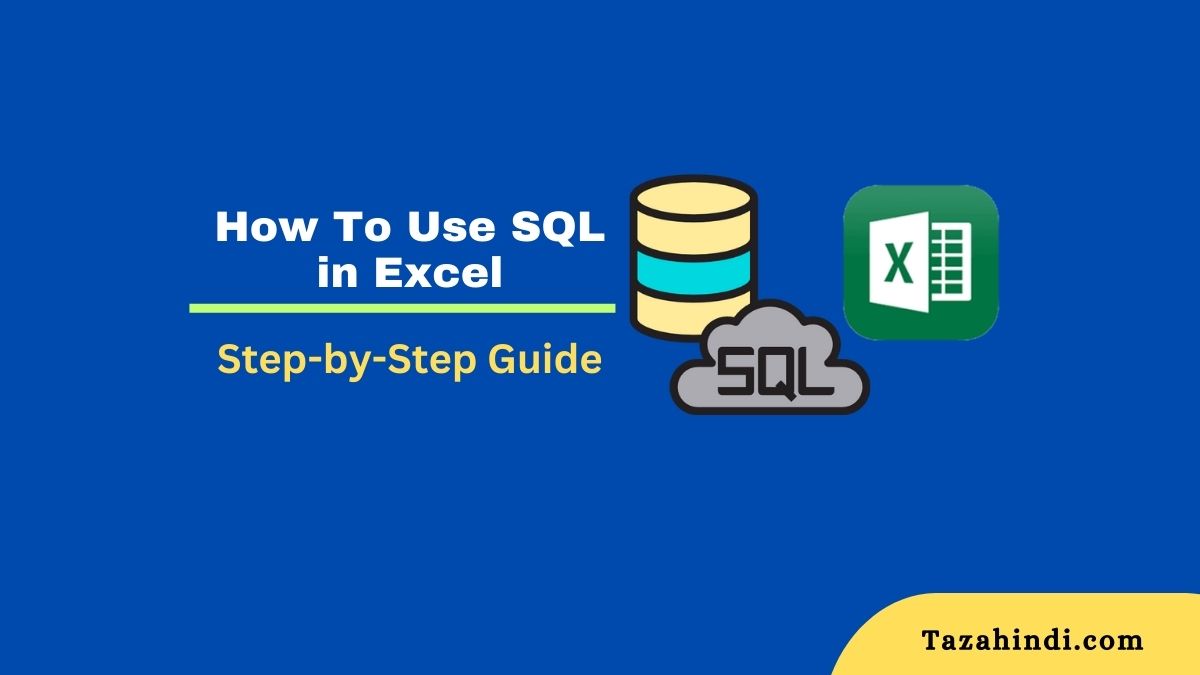How To Use SQL in Excel: Programming is an important skill that is used in almost every industry. It allows individuals to automate tasks and extract meaningful insights from large amounts of data. SQL is a programming language that is commonly used to manage and manipulate data in relational databases.
In this article, I will explain you, how does SQL work, how to use SQL in Excel, how to connect to the database in Excel, how to write SQL Queries in Excel and how to Analyzing Data in Excel, a popular spreadsheet program.
Before we dive into how to use SQL in Excel, let’s first understand what SQL is and how it works.
What is SQL?
SQL stands for Structured Query Language. It is a programming language that is used to manage and manipulate data in relational databases. SQL is used to perform tasks such as retrieving data from a database, inserting new data, updating existing data, and deleting data. SQL is a standard language that is used by many database management systems such as MySQL, Microsoft SQL Server, Oracle, and PostgreSQL.
What is Relational Database?
Relational databases are a type of database that stores data in tables. A table is composed of rows and columns, where each column signifies a different attribute of the data. The rows represent the actual data.
For example, a table that stores customer information might have columns for the customer’s name, address, and phone number. Each row would represent a different customer’s information.
How Does SQL Work?
SQL works by using commands to manipulate data in a relational database. These commands are sent to the database management system, which interprets them and performs the requested operation. SQL commands are grouped into several categories:
- Data Definition Language (DDL): Used to define the structure of a database, including tables, columns, and constraints.
- Data Manipulation Language (DML): Used to manipulate data in a database, including inserting, updating, and deleting data.
- Data Control Language (DCL): Used to control access to a database, including granting and revoking permissions.
- Transaction Control Language (TCL): Used to manage transactions, which are a series of SQL statements that are executed as a single unit of work.
Also Read: SQL for Data Science, How to Use SQL to Analyze Data
Now that we understand what SQL is and how it works, let’s explore how to use SQL in Excel.
How To Use SQL in Excel?
In order to use SQL in Excel, we first need to install the ODBC driver. Open Database Connectivity(ODBC) is a standard interface for accessing databases. The ODBC driver allows Excel to connect to a database and execute SQL queries.
Step 1: How to Install ODBC Driver
To install the ODBC driver, follow these steps:
- Go to the Microsoft website and download the appropriate ODBC driver for your version of Excel.
- Run the installer and follow the on-screen instructions to install the driver.
Step 2: How to Connect to the Database in Excel
Once the ODBC driver is installed, we can connect to the database from Excel. To do this, follow these steps:
- Open Excel and go to the Data tab.
- Click on the From Other Sources button and select From Microsoft Query.
- Select the ODBC data source that you just installed and click OK.
- Enter your username and password for the database.
- Select the table or tables that you want to query and click OK.
Step 3: How to Write SQL Queries in Excel
Now that we are connected to the database, we can write an SQL query to retrieve the data we need. To do this, follow these steps:
- In the Microsoft Query window, click on the SQL button.
- Enter your SQL query in the window that appears.
- Click on the Check Syntax button to make sure your query is valid.
- Click on the Return Data button to execute the query and retrieve the results.
Step 4: How to Analyzing Data in Excel
Once we have retrieved the data, we can analyze it in Excel using the tools that are available. For example, we can create charts and graphs to visualize the data, apply filters and sorting to view specific subsets of the data, and perform calculations using Excel’s built-in formulas.
Also Read: How to Create Tables in SQL
How to use SQL in Excel to retrieve data from a database?
Let’s walk through an example of Retrieving Sales Data.
Suppose we have a database that stores sales data for a XYZ company. The database has a table called “Sales” that contains the following columns:
- Date: the date of the sale
- Product: the name of the product sold
- Quantity: the quantity of the product sold
- Price: price per unit of the product
- Customer: the name of the customer who made the purchase
Our goal is to retrieve the total sales for each product by month for the past year.
Step 1: Install the ODBC Driver
Assuming we are using Excel on a Windows machine, we can download the ODBC driver for Microsoft SQL Server from the Microsoft website. Once the driver is downloaded, we can run the installer and follow the on-screen instructions to install it.
Step 2: Connect to the Database
Open Excel and go to the Data tab. Click on the From Other Sources button and select From Microsoft Query. In the Microsoft Query window, select the ODBC data source that we just installed and click OK. Enter your username and password for the database, and select the Sales table.
Step 3: Write the SQL Query
In the Microsoft Query window, click on the SQL button. Enter the following SQL query:
SELECT
YEAR(Date) AS Year,
MONTH(Date) AS Month,
Product,
SUM(Quantity * Price) AS TotalSales
FROM
Sales
WHERE
Date >= DATEADD(year, -1, GETDATE())
GROUP BY
YEAR(Date),
MONTH(Date),
Product
This query retrieves the year and month, product, and total sales for the past year. We use the YEAR and MONTH functions to extract the year and month from the Date column. We use the SUM function to calculate the total sales for each product by multiplying the quantity sold by the price per unit. We use the WHERE clause to filter the results to only include sales from the past year.
Step 4: Analyze the Data
Click on the Return Data button to execute the query and retrieve the results. The data will be returned to Excel in a table format.
We can use Excel’s built-in tools to analyze the data. For example, we can create a pivot table to summarize the data by product and month and can create a chart to visualize the data.
Also Read: MP Kisan Anudan Yojana: Benefits and How To Apply
Conclusion
In this article, you have learned about SQL, a programming language used to manage and manipulate data in relational databases. Also learned how to use SQL in Excel to retrieve data from a database. By following the steps outlined in this article, you can connect to a database, write SQL queries, and analyze the data in Excel using its built-in tools. SQL is a powerful tool for working with data and can be used to automate tasks and extract insights from large datasets. With the knowledge gained from this article, you can start using SQL in Excel to improve your data analysis and decision-making skills.
FAQs on Use SQL in Excel
-
Why use SQL in Excel?
Using SQL in Excel allows us to retrieve data from databases and analyze it using Excel’s built-in tools. This can be useful for tasks such as data analysis, reporting, and automation.
-
How to connect a database in Excel?
In Excel, go to the Data tab and click on the From Other Sources button. Select From Microsoft Query and choose the ODBC data source that you want to connect to. Enter your username and password for the database and select the table or tables that you want to retrieve data from.
-
What is an ODBC driver?
ODBC stands for Open Database Connectivity. An ODBC driver is a software component that allows applications to connect to and access data from a database using the ODBC standard.
-
How do I install an ODBC driver?
To install an ODBC driver, download the driver from the vendor’s website and run the installer. To complete the installation, you can follow the on-screen instructions.
-
How do I write a SQL query in Excel?
In the Microsoft Query window, click on the SQL button to open the SQL editor. Enter your SQL query in the editor and click OK to execute the query and retrieve the results.
-
How do I analyze the data in Excel?
Once you have retrieved the data from the database, you can use Excel’s built-in tools to analyze the data. For example, you can create pivot tables, charts, and use Excel’s formulas to perform calculations on the data.
-
What are some best practices for using SQL in Excel?
Some best practices for using SQL in Excel include keeping your SQL queries simple and concise, using parameterized queries to avoid SQL injection attacks, and properly formatting your data in Excel to ensure accurate analysis. It is also important to test your SQL queries before running them on large datasets.



